Top Food and Drink Trends for Summer
June 14, 2024
There are very few activities we find more exciting or interesting than trying new foods and cooking our favorite innovations at home. Summer is…
Read This Post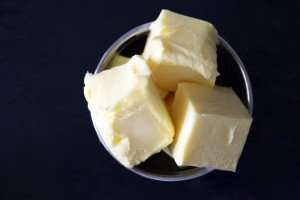 Butter.
Butter.
Yes, butter. Today we’re all about butter, and it’s not because it’s national butter day (evidently that is October 25th–who knew?), nor because we’ve accidentally over-whipped the cream and ended up with it by accident (yes, that has happened).
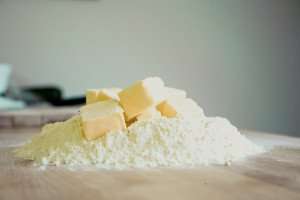 So why butter? Butter is one of the most versatile of ingredients. It is part of the magic that goes into such dissimilar things as flaky puff pastry and creamy hollandaise.
So why butter? Butter is one of the most versatile of ingredients. It is part of the magic that goes into such dissimilar things as flaky puff pastry and creamy hollandaise.
Butter is usually made from cow’s milk, but can be made from the milk of many mammals, including goats, sheep, and yaks. As a substance, butter contains milk fat, milk solids, and water (usually around 82% fat, around 2% milk solids, and around 16% water). If you agitate cream to the point that the milk fats start to combine into butter, it will leave behind a thinner milk – buttermilk!
Visit France on a culinary vacation with TIK.
“If you’re afraid of butter, as many people are nowadays, just put in cream!”
Julia Child
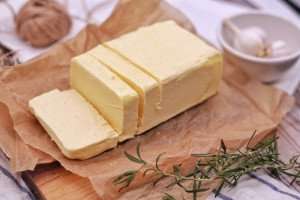 Making Butter
Making ButterI make butter with my kids in the mixer, and it’s also a magical process. It takes a while, but the cream becomes thicker and thicker as it is whipped, then starts (strangely) to lose its thickness, and suddenly separates into two completely different substances. We pour the buttermilk off (I always mean to save it for other recipes, but my kids invariably drink it before it even hits the fridge), rinse the butter solids, add a bit of salt, and voilà. Homemade butter.
You may have heard of “clarified” butter, and that’s basically just refining the butter until only the milk fat remains while skimming off the milk solids and water. Why bother? The milk solids are what burn, so clarified butter can be used at much higher temperatures (but cannot brown, so if you’re looking for the nuttiness of a brown butter, the solids are essential). The milk solids are also what spoils, so clarified butter keeps longer than regular butter.
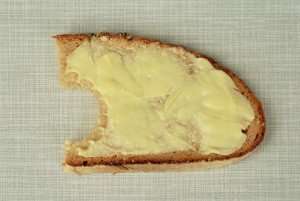 How do you make clarified butter? Simple, you just melt butter over low to medium heat and skim the frothy substance off the top. Keep skimming until all the froth is gone, then ladle the clear, pure butterfat out, leaving behind the milky substance at the bottom of the pan, which is the water. Kitchen tip: save the part you skim off the top, it is perfectly delicious for other recipes. (You can also make it by letting the milk solids start to clump and sink to the bottom, and then strain it through cheesecloth.)
How do you make clarified butter? Simple, you just melt butter over low to medium heat and skim the frothy substance off the top. Keep skimming until all the froth is gone, then ladle the clear, pure butterfat out, leaving behind the milky substance at the bottom of the pan, which is the water. Kitchen tip: save the part you skim off the top, it is perfectly delicious for other recipes. (You can also make it by letting the milk solids start to clump and sink to the bottom, and then strain it through cheesecloth.)
You may also have heard of ghee, which is a staple of Indian cooking. Ghee is much like clarified butter (indeed many people use them interchangeably), but ghee tastes slightly different because the milk solids are allowed to start to brown before they are removed, usually by being strained out.
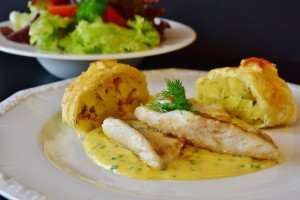 Fun Butter Facts
Fun Butter FactsYou may also have heard of cultured butter. It sounds very refined! But it is basically butter made from milk that has started to ferment. This was originally due to the fact that it took several days to collect the cream and make butter, and the milk, kept at room temperature, therefore fermented naturally. But it is now usually the result of adding bacteria to start the fermentation process in the same way that yogurt is made.
Discover Normandy butter on a culinary tour.
 There are many places known for their butter, including (and especially) France. Butter is intrinsic to French cuisine, or at least to the parts of it that do not border the Mediterranean, where olive oil reigns supreme. And indeed, Brittany and Normandy are two of the world’s most famed producers of butter, including the famed Beurre d’Isigny, an AOC butter from Normandy. (This might be why we love the garlic butter from Normandy’s Chef Sinead so much!)
There are many places known for their butter, including (and especially) France. Butter is intrinsic to French cuisine, or at least to the parts of it that do not border the Mediterranean, where olive oil reigns supreme. And indeed, Brittany and Normandy are two of the world’s most famed producers of butter, including the famed Beurre d’Isigny, an AOC butter from Normandy. (This might be why we love the garlic butter from Normandy’s Chef Sinead so much!)
One thing that many Americans don’t realize is that butter does not need to be refrigerated. When cold, butter hardens, which is useful for much pastry making, but if left at room temperature is wonderfully spreadable. Of course, if you don’t use butter much, you’ll get a longer shelf life if you put it in the fridge, but we keep it out (although in a cool location and covered), and use it constantly, long before it can start to turn rancid.
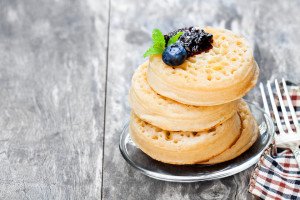 How We Use Butter
How We Use ButterWhat do we use all that butter for? Well, it is excellent on toast, crumpets, muffins, pancakes, and the like. And on a slice of warm, homemade bread? Amazing.
We add it liberally to certain soups, make compound butter by mixing it with other ingredients like garlic and herbs, honey, anchovies, or other spices. I’ve heard of people adding it their coffee, although that I have not tried myself.
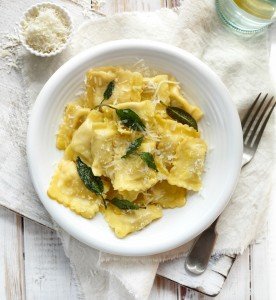 It’s a perfect pairing for pasta, including in an authentic Alfredo sauce (which, as we keep explaining and despite thoughts to the contrary, does not include cream, just butter, hot pasta water, and parmesan). Or, fry up a little sage in butter, toss some Piedmontese Ravioli in, and you’ll have an amazingly delicious meal!
It’s a perfect pairing for pasta, including in an authentic Alfredo sauce (which, as we keep explaining and despite thoughts to the contrary, does not include cream, just butter, hot pasta water, and parmesan). Or, fry up a little sage in butter, toss some Piedmontese Ravioli in, and you’ll have an amazingly delicious meal!
It’s used in countless desserts, from baklava to cakes, from pastries to cookies and shortbread.
 Butter is an essential ingredient in one of my favorite sauces, béchamel, as it is used to make the roux that thickens the milk-based sauce. But it is (amazingly!) the main liquid ingredient in another of my favorite sauces: hollandaise! And it is one of the magical ingredients of pastries, whether in cold layers such as in puff pastry, or cooked to create a pâte à choux.
Butter is an essential ingredient in one of my favorite sauces, béchamel, as it is used to make the roux that thickens the milk-based sauce. But it is (amazingly!) the main liquid ingredient in another of my favorite sauces: hollandaise! And it is one of the magical ingredients of pastries, whether in cold layers such as in puff pastry, or cooked to create a pâte à choux.
Check out our cooking vacation itineraries in Paris.
To finish up our exploration of butter, here is a recipe for hollandaise, one of the classic “Mother” sauces of French cuisine. Use it for a classic eggs Benedict, with savory crepes, fish, or vegetables.
Serves: 4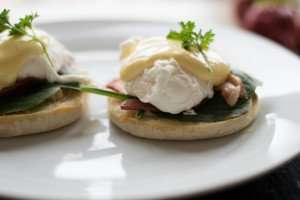
Prep time: 5 minutes
Cook time: 5 minutes
Cook method: Bain-Marie
Ingredients:
Instructions: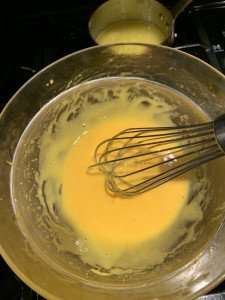
1. Melt the butter in a separate pot and set aside. (You can also use clarified butter.)
2. Whisk the egg yolks in a glass or stainless steel bowl until they have lightened a bit in color and started to thicken, then add the lemon juice and continue to whisk vigorously until about double the original volume.
3. Place the bowl over the top of a medium saucepan with an inch of hot water simmering below it. Continue whisking until the yolk mixture is heated, but do not let it get too hot or it will scramble the eggs.
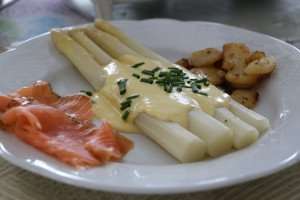 4. Slowly add the butter to the eggs a little at a time, whisking vigorously, until all the butter is incorporated. If the sauce starts to “break” add in a teaspoon of very hot water. (If necessary, repeat this step.)
4. Slowly add the butter to the eggs a little at a time, whisking vigorously, until all the butter is incorporated. If the sauce starts to “break” add in a teaspoon of very hot water. (If necessary, repeat this step.)
5. Remove from the heat and add salt and pepper to taste. You can use a bit of hot water to thin the sauce to the desired consistency, depending on the recipe for which you are using it. If you are not using it immediately, cover the bowl and keep it in a warm spot until you’re ready.
 What is your favorite use of butter? Croissants? Hollandaise? Or simply spread over a slice of freshly baked bread?
What is your favorite use of butter? Croissants? Hollandaise? Or simply spread over a slice of freshly baked bread?
By Peg Kern
Sign up to receive our newsletter, which includes travel tips, recipes, promotions, and information on our best cooking vacations.
Find more photos, videos, food facts, and travel stories from The International Kitchen on Facebook, Instagram, Pinterest, Twitter, and YouTube.
Love the Julia Child quote!
She was full of great food quotes!